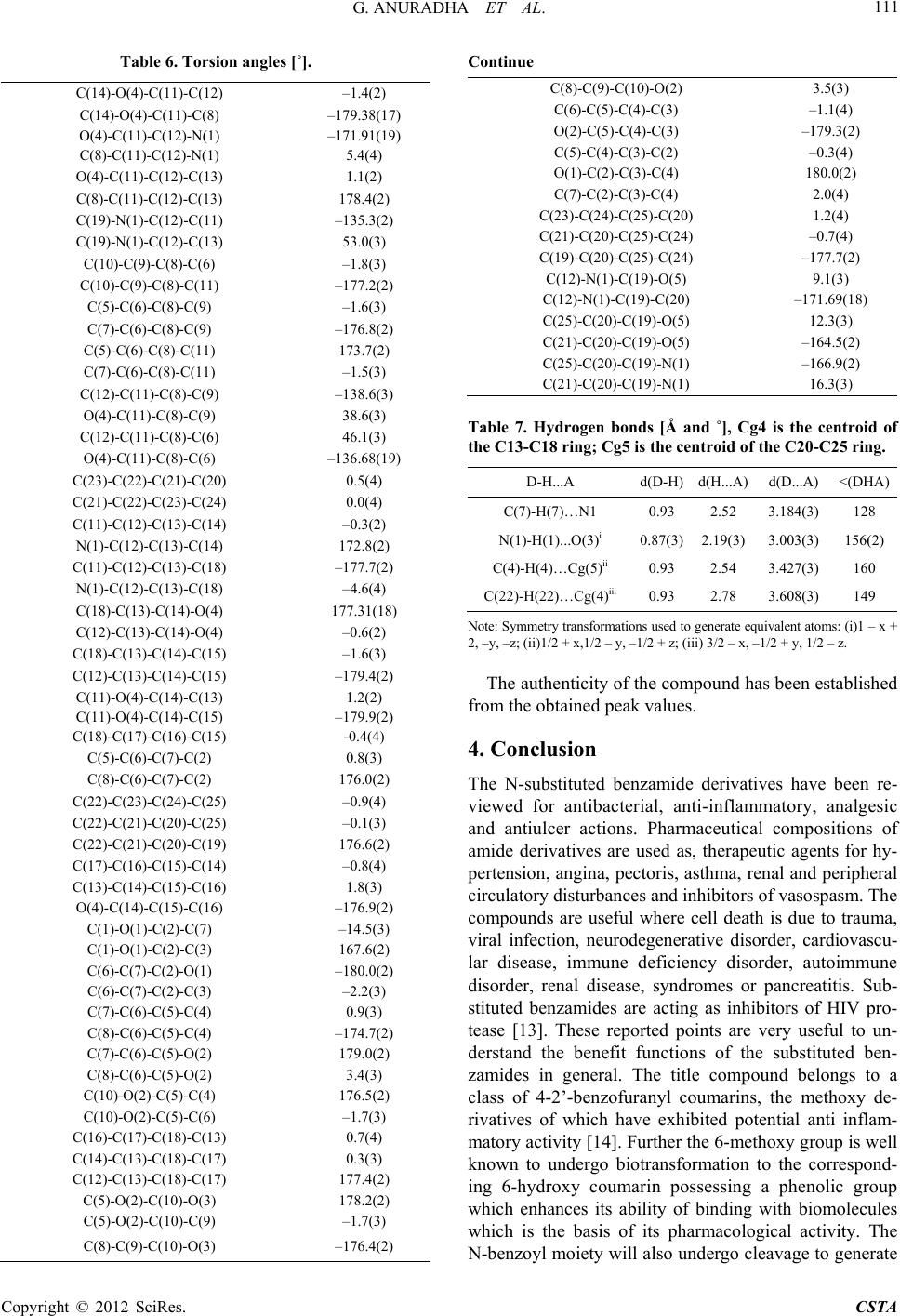
G. ANURADHA ET AL. 111
Table 6. Torsion angles [˚].
C(14)-O(4)-C(11)-C(12) –1.4(2)
C(14)-O(4)-C(11)-C(8) –179.38(17)
O(4)-C(11)-C(12)-N(1) –171.91(19)
C(8)-C(11)-C(12)-N(1) 5.4(4)
O(4)-C(11)-C(12)-C(13) 1.1(2)
C(8)-C(11)-C(12)-C(13) 178.4(2)
C(19)-N(1)-C(12)-C(11) –135.3(2)
C(19)-N(1)-C(12)-C(13) 53.0(3)
C(10)-C(9)-C(8)-C(6) –1.8(3)
C(10)-C(9)-C(8)-C(11) –177.2(2)
C(5)-C(6)-C(8)-C(9) –1.6(3)
C(7)-C(6)-C(8)-C(9) –176.8(2)
C(5)-C(6)-C(8)-C(11) 173.7(2)
C(7)-C(6)-C(8)-C(11) –1.5(3)
C(12)-C(11)-C(8)-C(9) –138.6(3)
O(4)-C(11)-C(8)-C(9) 38.6(3)
C(12)-C(11)-C(8)-C(6) 46.1(3)
O(4)-C(11)-C(8)-C(6) –136.68(19)
C(23)-C(22)-C(21)-C(20) 0.5(4)
C(21)-C(22)-C(23)-C(24) 0.0(4)
C(11)-C(12)-C(13)-C(14) –0.3(2)
N(1)-C(12)-C(13)-C(14) 172.8(2)
C(11)-C(12)-C(13)-C(18) –177.7(2)
N(1)-C(12)-C(13)-C(18) –4.6(4)
C(18)-C(13)-C(14)-O(4) 177.31(18)
C(12)-C(13)-C(14)-O(4) –0.6(2)
C(18)-C(13)-C(14)-C(15) –1.6(3)
C(12)-C(13)-C(14)-C(15) –179.4(2)
C(11)-O(4)-C(14)-C(13) 1.2(2)
C(11)-O(4)-C(14)-C(15) –179.9(2)
C(18)-C(17)-C(16)-C(15) -0.4(4)
C(5)-C(6)-C(7)-C(2) 0.8(3)
C(8)-C(6)-C(7)-C(2) 176.0(2)
C(22)-C(23)-C(24)-C(25) –0.9(4)
C(22)-C(21)-C(20)-C(25) –0.1(3)
C(22)-C(21)-C(20)-C(19) 176.6(2)
C(17)-C(16)-C(15)-C(14) –0.8(4)
C(13)-C(14)-C(15)-C(16) 1.8(3)
O(4)-C(14)-C(15)-C(16) –176.9(2)
C(1)-O(1)-C(2)-C(7) –14.5(3)
C(1)-O(1)-C(2)-C(3) 167.6(2)
C(6)-C(7)-C(2)-O(1) –180.0(2)
C(6)-C(7)-C(2)-C(3) –2.2(3)
C(7)-C(6)-C(5)-C(4) 0.9(3)
C(8)-C(6)-C(5)-C(4) –174.7(2)
C(7)-C(6)-C(5)-O(2) 179.0(2)
C(8)-C(6)-C(5)-O(2) 3.4(3)
C(10)-O(2)-C(5)-C(4) 176.5(2)
C(10)-O(2)-C(5)-C(6) –1.7(3)
C(16)-C(17)-C(18)-C(13) 0.7(4)
C(14)-C(13)-C(18)-C(17) 0.3(3)
C(12)-C(13)-C(18)-C(17) 177.4(2)
C(5)-O(2)-C(10)-O(3) 178.2(2)
C(5)-O(2)-C(10)-C(9) –1.7(3)
C(8)-C(9)-C(10)-O(3) –176.4(2)
Continue
C(8)-C(9)-C(10)-O(2) 3.5(3)
C(6)-C(5)-C(4)-C(3) –1.1(4)
O(2)-C(5)-C(4)-C(3) –179.3(2)
C(5)-C(4)-C(3)-C(2) –0.3(4)
O(1)-C(2)-C(3)-C(4) 180.0(2)
C(7)-C(2)-C(3)-C(4) 2.0(4)
C(23)-C(24)-C(25)-C(20) 1.2(4)
C(21)-C(20)-C(25)-C(24) –0.7(4)
C(19)-C(20)-C(25)-C(24) –177.7(2)
C(12)-N(1)-C(19)-O(5) 9.1(3)
C(12)-N(1)-C(19)-C(20) –171.69(18)
C(25)-C(20)-C(19)-O(5) 12.3(3)
C(21)-C(20)-C(19)-O(5) –164.5(2)
C(25)-C(20)-C(19)-N(1) –166.9(2)
C(21)-C(20)-C(19)-N(1) 16.3(3)
Table 7. Hydrogen bonds [Å and ˚], Cg4 is the centroid of
the C13-C18 ring; Cg5 is the centroid of the C20-C25 ring.
D-H...A d(D-H) d(H...A) d(D...A)<(DHA)
C(7)-H(7)…N1 0.93 2.52 3.184(3)128
N(1)-H(1)...O (3)i 0.87(3) 2.19(3) 3.003(3)156(2)
C(4)-H(4)…Cg(5)ii 0.93 2.54 3.427(3)160
C(22)-H(22)…Cg(4)iii 0.93 2.78 3.608(3)149
Note: Symmetry transformations used to generate equivalent atoms: (i)1 – x +
2, –y, –z; (ii)1/2 + x,1/2 – y, –1/2 + z; (iii) 3/2 – x, –1/2 + y, 1/2 – z.
The authenticity of the compound has been established
from the obtained peak values.
4. Conclusion
The N-substituted benzamide derivatives have been re-
viewed for antibacterial, anti-inflammatory, analgesic
and antiulcer actions. Pharmaceutical compositions of
amide derivatives are used as, therapeutic agents for hy-
pertension, angina, pectoris, asthma, renal and peripheral
circulatory disturbances and inhibitors of vasospasm. The
compounds are useful where cell death is due to trauma,
viral infection, neurodegenerative disorder, cardiovascu-
lar disease, immune deficiency disorder, autoimmune
disorder, renal disease, syndromes or pancreatitis. Sub-
stituted benzamides are acting as inhibitors of HIV pro-
tease [13]. These reported points are very useful to un-
derstand the benefit functions of the substituted ben-
zamides in general. The title compound belongs to a
class of 4-2’-benzofuranyl coumarins, the methoxy de-
rivatives of which have exhibited potential anti inflam-
matory activity [14]. Further the 6-methoxy group is well
known to undergo biotransformation to the correspond-
ing 6-hydroxy coumarin possessing a phenolic group
which enhances its ability of binding with biomolecules
which is the basis of its pharmacological activity. The
N-benzoyl moiety will also undergo cleavage to generate
Copyright © 2012 SciRes. CSTA